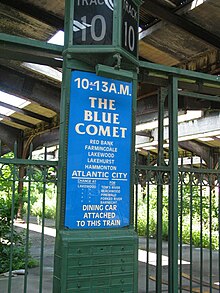Blue Comet

A reproduced sign for former Blue Comet service at Communipaw Terminal in Jersey City
|
|||||
| Overview | |||||
|---|---|---|---|---|---|
| Service type | Inter-city rail | ||||
| Status | Discontinued | ||||
| Locale | New Jersey, United States | ||||
| First service | February 21, 1929 | ||||
| Last service | September 27, 1941 | ||||
| Former operator(s) | Central Railroad of New Jersey | ||||
| Route | |||||
| Start | Jersey City, New Jersey | ||||
| End | Atlantic City, New Jersey | ||||
| Average journey time | 3 hours | ||||
| Service frequency | varied | ||||
| On-board services | |||||
| Seating arrangements | Reserved coach seat | ||||
| Catering facilities | Dining car | ||||
| Observation facilities | Observation car | ||||
| Technical | |||||
| Track gauge | 1,435 mm (4 ft 8 1⁄2 in) | ||||
|
|||||
| Route map | ||||||||||||||||||||||||||||||||||||||||||||||||||||||||||||||||||||||||||||||||||||||||||||||||||
|---|---|---|---|---|---|---|---|---|---|---|---|---|---|---|---|---|---|---|---|---|---|---|---|---|---|---|---|---|---|---|---|---|---|---|---|---|---|---|---|---|---|---|---|---|---|---|---|---|---|---|---|---|---|---|---|---|---|---|---|---|---|---|---|---|---|---|---|---|---|---|---|---|---|---|---|---|---|---|---|---|---|---|---|---|---|---|---|---|---|---|---|---|---|---|---|---|---|---|
|
||||||||||||||||||||||||||||||||||||||||||||||||||||||||||||||||||||||||||||||||||||||||||||||||||
The Blue Comet was a named passenger train operated by Central Railroad of New Jersey from 1929 to 1941 between the New York metropolitan area and Atlantic City.
Designed by Central Railroad of New Jersey (CNJ) president R.B. White in 1928, this train whisked passengers from Communipaw Terminal in Jersey City to Atlantic City, making the total trip from Manhattan (via ferry to the Jersey City terminal) to Atlantic City in three hours. The Blue Comet would take NY&LB trackage to Red Bank, then follow the Southern Division Main Line to Winslow Junction, where it would travel over the Atlantic City Railroad's tracks to Atlantic City.
The colors chosen for the Blue Comet's locomotive and passenger cars were ultramarine and Packard Blue, for the sea, cream, for the sandy coastal beaches, and nickel. The tickets for the train were blue, the dining car chairs were upholstered in blue linen, and the porters were dressed in blue as well. The locomotive was capable of 100 miles per hour, and the railroad claimed the train itself was the first east of the Mississippi to be equipped with roller bearings for easy starting and stopping.
Inaugurated on February 21, 1929, the Blue Comet was designed to provide coach passengers with deluxe equipment, accommodations, and service at a regular coach fare. The first revenue passengers to board the CNJ's new flagship at Communipaw Terminal were Miss Beatrice Winter and Miss Helen Lewis of New York. As the Blue Comet made its way to Atlantic City, it was put on display for patrons, railfans, and local residents to see and inspect. Thousands of spectators along the line came to see the new train. This was due in part to a clever ad campaign via radio and newspaper which spurred public interest. Following its first arrival in Atlantic City, a formal dinner was held for railroad officials at the Hotel Dennis. The Blue Comet was published in several periodicals and trade magazines such as Railway Age (March 1929), Fortune (The first issue in February, 1930), The Modelmaker, and several advertisements for ELESCO Superheaters and Feedwater Heaters. Periodic articles about the train would also appear in the New York Times, Philadelphia Enquirer, and local papers such as the Red Bank Register. It was even featured in a British 1937 Gallaher Ltd collection of tobacco cards entitled "Trains of the world." Billed as the "Seashore's Finest Train", it was dubbed a "Symphony in Blue." Lionel founder Joshua Lionel Cowen, was among those who frequently rode the Blue Comet. Inspired by the train's elegant beauty, speed, and the sublime power of its towering locomotive, Lionel offered a standard gauge model of the train in 1930. This gave the train and Lionel an almost mythical quality.
...
Wikipedia
